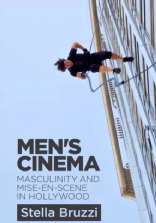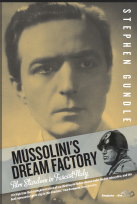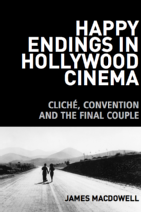Recent Books

Men's Cinema: Masculinity and Mise-en-Scene in Hollywood
by Stella Bruzzi
The first full length study of masculinity and film style. Men’s Cinema offers a fresh theorisation of men in Hollywood cinema via a theoretical discussion of definitions of masculinity and the close textual analysis of classic and contemporary films. Through an examination of mise-en-scène, Men’s Cinema moves beyond discussions of representation and narrative to an exploration of the physical or instinctive effects of cinema and how we are invited to engage with, desire or identify with Hollywood's vision of men and masculinity. By delineating how Hollywood has built up and refined the language of men's cinema through a series of recurrent, refined tropes, this book critically explores masculinity and the concept of a male aesthetic within film. Films discussed include: The Deer Hunter, Dirty Harry, Goodfellas, Inception, Mission Impossible: Ghost Protocol, Once Upon a Time in the West, Point Break, Raging Bull, Rebel Without A Cause, Reservoir Dogs, Sherlock Holmes, There’s Always Tomorrow, The Wild Bunch.

Letters and Literacy in Hollywood Film by Edward Gallafent
Films are full of words on the screen. There are letters that come in the post, written and printed papers, and epitaphs. They can be declarations of love, or the words that tell us where we are or what is happening, varying from the most intimate confessions to straightforward signs. We do not often pause to think about our own interpretation of them, yet our response to reading and writing can be an important part of how we understand films. This book looks in detail at five films – Letter from an Unknown Woman; All This, and Heaven Too; The Man who Shot Liberty Valance; Into the Wild and The Reader – and reveals how words work on screen, and the importance of literacy in their worlds. It sheds new light on some classic films and explores the uses of this form of expression in the work of modern film makers.

Mussolini's Dream Factory: Film Stardom in Fascist Italy
by Stephen Gundle
This book offers the first extended analysis of film stardom in Fascist Italy, focusing on the period from the start of sound cinema to the final end of Fascism in 1945. The author examines the development of an Italian star system, evaluates its place in film production and distribution, and explores its relationships with the political sphere and with broader commercial culture. The popular press, along with other evidence, is used to assess the extent of public engagement with film stars. Several major stars, including Isa Miranda, Vittorio De Sica, Amedeo Nazzari and Alida Valli, are closely analysed in terms of their screen performances and professional trajectories, including their fates in the aftermath of the Fascist regime. The book makes an original contribution to the understanding of Italian Fascism and the cinema of the period by tackling a field hitherto neglected, despite it being deemed important enough by the regime to warrant sustained attention and interference. A final chapter explores the place of the stars in popular memory and representations of the Fascist film world in postwar cinema.
'This is an outstanding book in every respect. It is beautifully written, clear, concise, no professional jargon, yet based on a confident grasp of all the relevant criticism as well as primary sources in a number of languages…It is high time that a complete revision of our thinking on Italian cinema under fascism takes place, and this book represents a giant step in this direction.' – Peter Bondanella, Emer., Indiana University
'I thoroughly enjoyed reading this book. It is obviously a study written with great enthusiasm for its subject—Italian stardom. The work covers a wide terrain involving the nature of the regime as it entails cinema, examines the roles that the fascist state played from the late 1920s to the early 1940s (and shortly thereafter), designating the figures responsible for its development and implementation, the producers and film directors who played a major role, and most central for the study, the evolution of the star system over the course of the twenty years of the regime.' – Marcia Landy, University of Pittsburgh

Happy Endings in Hollywood Cinema: Cliché, Convention and the Final Couple
by James MacDowell
This book offers the first in-depth examination of one of the most overused and under-analysed concepts in discussions of American cinema. Concentrating especially on conclusions featuring an ultimate romantic union - the final couple - this wide-ranging investigation probes traditional associations between the 'happy ending' and homogeneity, closure, 'unrealism', and ideological conservatism, testing widespread assumptions against the evidence offered by a range of classical and contemporary Hollywood films. Breaking new critical ground, the monograph encourages students and scholars of film to reconsider some tenacious critical preconceptions, inviting them to approach afresh their understandings of perhaps the most infamous narrative convention in Hollywood cinema.
'MacDowell quietly but brilliantly questions widespread misconceptions about Hollywood endings, and convincingly argues for their variety and complexity, as well as their emotional and intellectual appeal. The book’s combination of exceptionally smart in-depth textual analysis and theoretical speculation makes it compulsory reading for scholars and students for whom the films themselves are still the main focus of our discipline. A wonderful book.' – Celestino Deleyto, University of Zaragoza, Spain.
 Joseph Cornell Versus Cinema by Dr Michael Pigott
Joseph Cornell Versus Cinema by Dr Michael Pigott
Joseph Cornell is one of the most significant American artists of the twentieth century. His famous boxes and collage work have been widely admired and studied. His extraordinary body of film work, including Rose Hobart (1936) and By Night with Torch and Spear (c1942), has been much less explored, yet, as Michael Pigott argues, it is consistent with his creative vision and a serious contribution to twentieth century avant-garde cinema. In Joseph Cornell Versus Cinema, Michael Pigott examines Cornell’s filmmaking on its own terms, as a series of innovative, idiosyncratic and seminal engagements with the medium of film. He argues that Cornell’s work is highly significant in terms of understanding how we relate and have related to moving images in both the twentieth and twenty-first centuries. Pigott traces some of the key themes running through the artist’s film work – found footage; texture and affect; and time and the everyday – revealing the extent to which Cornell was ahead of his time in establishing radically new terms of aesthetic and cultural engagement and valuation. Key questions addressed in Cornell’s film work include the role of the spectator as an active participant and the nature of knowledge transfer, understanding and aesthetic experience. His work predicts many current innovations. Cornell remixes found materials from warehouses and junkshops much as contemporary remix artists work with materials from the internet: an analogue prefiguring of the role of contemporary digital technology. Joseph Cornell Versus Cinema is an important contribution to our knowledge of twentieth century culture and especially the relationship between art and film. It will appeal to scholars and students in both fields, as well as American studies and cultural studies.
"Just as Cornell’s boxes or films are both idiosyncratic masterpieces and collections of random tidbits, so Joseph Cornell Versus Cinema is not, as Pigott’s first lines tell us, a book about Cornell’s films but rather a book about their significance to ‘the project of understanding how we relate to moving images’.”

Fashion Cultures Revisited: Theories, Explorations and Analysis
Edited by Stella Bruzzi (University of Warwick) and Pamela Church Gibson (London College of Fashion, University of the Arts London)
Following on from the ground-breaking collection Fashion Cultures, this second anthology, Fashion Cultures Revisited, contains 26 newly commissioned chapters exploring fashion culture from the start of the new millennium to the present day. Fashion Cultures Revisited explores every facet of contemporary fashion culture and the associated spheres of photography, magazines and television, and shopping. The book is divided into six parts, each discussing different aspects of fashion culture:s hopping, spaces and globalisation, changing imagery, changing media, altered landscapes, new modes of production, icons and their legacies, contestation, compliance, feminisms, making masculinities.
For more publications by Film & TV please visit the People section.
